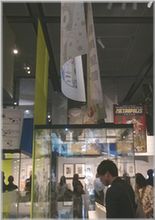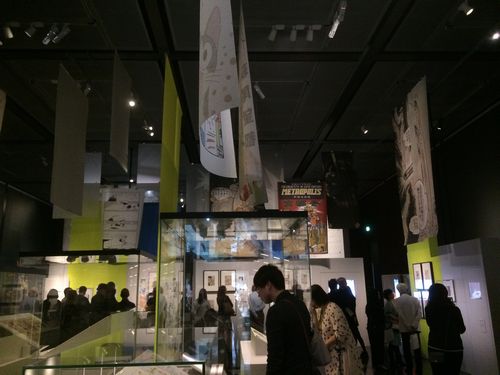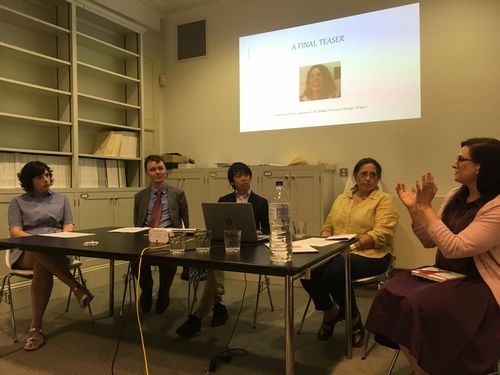Manga’s capacity to cross national and artistic boundaries

In late May 2019, the British Museum opened the largest manga exhibition ever held outside Japan.
That such a prestigious and historic institution would undertake a massive exhibition on the subject of manga—a subculture-tinged, foreign-born medium of expression generally viewed as lightweight compared to literature or drama—attracted widespread notice, and not only in England and Japan.
Manga’s influence has extended across not only national borders but also literary and artistic genres. One example is in cinema. Hiroyuki Kitaura, a research fellow with a specialty in film at the U.K.-based Sainsbury Institute for the Study of Japanese Arts and Cultures, was invited to view the British Museum’s Manga exhibition. We asked Dr. Kitaura about his impressions of the show, the opening reception, and the impact of manga on filmmaking.
Q: What impressed you most about the British Museum Manga exhibition?
The most memorable things for me were the introductory part of the show and the section titled “The Art of Manga” that focused on manga’s artistic aspects.
Upon entering the hall you first encounter the words of Alice from Lewis Carroll’s great English novel Alice’s Adventures in Wonderland: “What is the use of a book without pictures or conversation?” From there the displays go on to introduce Japanese manga that have Alice as a motif. “Books without pictures or conversation” refers, of course, to novels and other forms of traditional British print culture. So the exhibition uses Alice as a bridge linking British print culture to Japanese manga culture, which is based on pictures and conversation. I thought this was a remarkable way of bringing England and Japan together at the beginning of the show.
As for “The Art of Manga,” it seemed to me that this section sought to rebut the perception of manga as nothing more than entertainment for children by arguing for recognition of the medium’s artistic elements. I thought it reflected a determination on the part of the British Museum to offer a new perspective on manga.
Q: Lately it seems a growing number of Japanese films are based on manga. What do you think is behind this trend?
Long ago, film companies in Japan made movies in their own studios, with directors, staff and actors under exclusive contract, and distributed the films to theaters that were also under contract. That is how they made a profit. It was known as the studio system. However, this system ceased to function in the 1970s, when Japan’s film industry went into decline.
In its place, publishing houses and TV broadcasting companies began to make movies. Nowadays businesses from many different industries engage in filmmaking, and among them are manga publishers. It’s become the norm for several companies—notably film studios and publishers—to form “production committees” to make commercial films together. The studio hopes to get a hit by turning a popular manga into a movie, while the publisher anticipates that the film will boost sales of the manga. This trend has become especially pronounced since the early 2000s, and with it the number of manga-based films has soared.
Q: What sort of research are you doing at the Sainsbury Institute?
I’m investigating how Japanese movies and anime found their way overseas in the postwar era. For example, the domestic market for Japanese films began to shrink in the late 1950s, prompting the studios to look to overseas markets more than they had before. In the case of the U.K., one of Japan’s major studios, Shochiku, contracted with a British distributor in 1960 with the aim of making inroads into the British film market.
Q: Do you think the current global boom in Japanese anime and other films is a result of the “Cool Japan” campaign that has been underway for the past ten or twenty years? Or is it unrelated?
I think it’s important to recognize that the spread of Japanese anime and film overseas began earlier than that. To be sure, initiatives like Cool Japan promoted by the government also provide an incentive to look abroad. But to take one example, Toei Animation, a subsidiary of the film giant Toei that has been associated with such anime legends as Osamu Tezuka and Hayao Miyazaki, was founded in 1956 and has long been an active exporter of anime.
So if we wish to analyze the current status of Japanese anime and film, we have to look into the historical background. As it happens, I am currently planning a workshop [held in July] with British and Japanese researchers to explore this very phenomenon, the global spread of Japanese anime and film.
Dr. Kitaura also mentioned that at the reception for the Manga exhibition, he was greeted by someone in costume as the Pokemon character Pikachu—further evidence that manga now span national borders and media alike in their growing role as raw material for anime and live-action films.
Having left Japan to pursue film studies in another country and culture, what’s next for Dr. Kitaura? We look forward to seeing what other frontiers he will cross in the course of his research on film and anime.
(Interview: Ayumi Koso)

The Manga exhibition at the British Museum (May 23 to August 26, 2019)

“Workshop: Historical Perspectives on the Distribution and Adaptation of Japanese Live
Action Films and Anime Overseas” held in July at the Sainsbury Institute for the Study of
Japanese Arts and Cultures, UK.

Hiroyuki Kitaura is a Robert and Lisa Sainsbury Fellow at Sainsbury Institute for the Study of Japanese Arts and Cultures, where he specializes in film and media studies. After earning his PhD in 2013 from theKyoto University Graduate School of Human and Environmental Studies, he served as assistant professor at theInternational Research Center for Japanese Studies before taking his current position in 2018. He is the author of Japanese Movies during the Growth Period of Television: Dramas in Media Interactions (University of Nagoya Press, 2018). Currently writing a monthly column “From Britain’s ‘Little Kyoto’: Norwich’s Japanese Studies and Environs” for the Kyoto Shinbun [newspaper].
